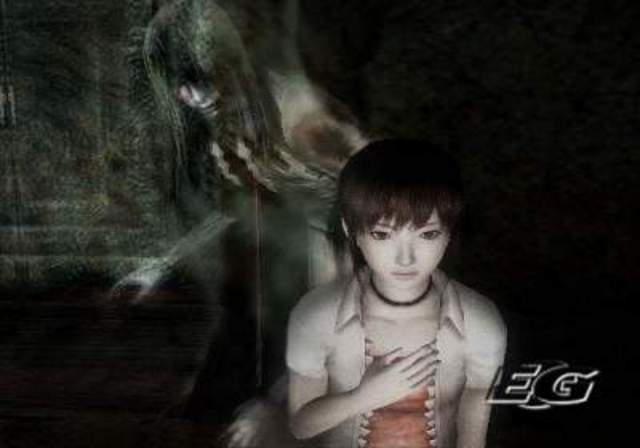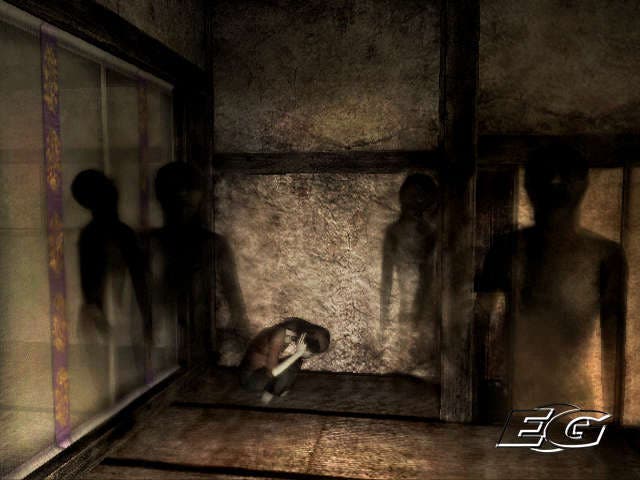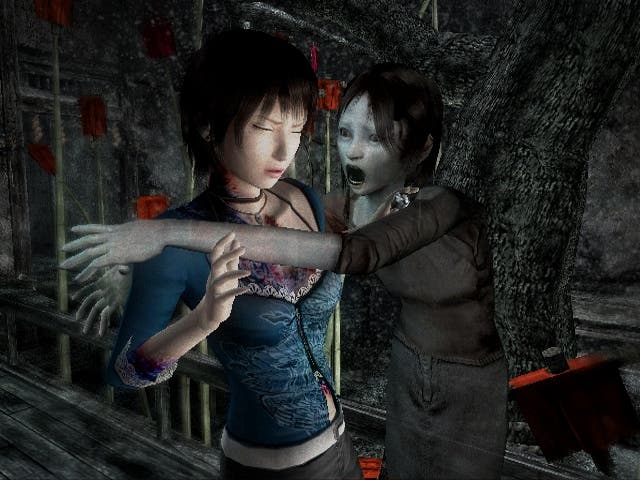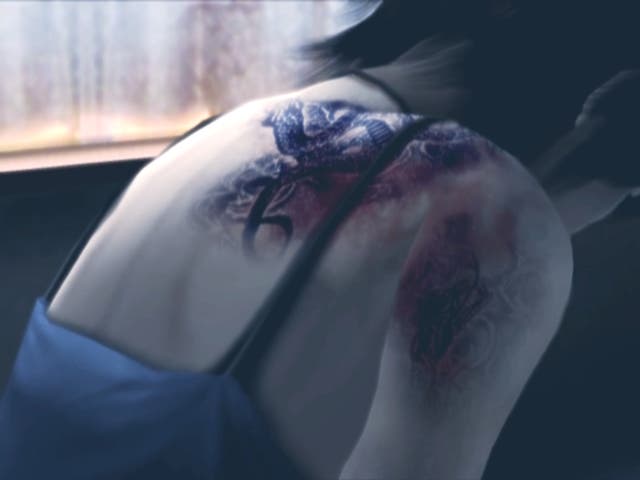Project Zero 3: The Tormented
Sweet dreams.
No matter how many rave reviews the Project Zero games seem to get over here, a mixture of publisher indifference, retailer apathy and consumer foolishness has maddeningly conspired to completely scupper any chance of Tecmo's superb survival-horror series selling in Europe. Now onto its fourth European publisher, we can only hope that Take-Two recognises the strength of the series and can do a little more than push it into the dark recesses of store shelves when it finally gets its belated release across the continent next month.
Now that we've got our traditional Exasperated Commercial Failure(TM) rant over with (and in record time! First paragraph!), the basic gist is that the latest in the hugely admired Fatal Frame/Project Zero series is absolutely brilliant as well. In the words of Simon Pegg: Skip to the end. 8/10. Job done, go and buy it (on 24th February, before you ask).
You might reasonably ask that if it's so goddamned brilliant then why only an eight? Sure, in survival-horror I've-completed-all-six-Resis and all-four-Silent Hills-uberfan's parlance, it's a nailed-on must buy. But cruel, heartless reviewers that we are, we have to douse the exuberance in a few tears of regret. Tecmo has done what do many developers do: made roughly the same game again, added a few nice new features, padded out the content a bit and said 'thankyouverymuchthat'llbefiftyEuroplease'.
Shine off

Yes, Tecmo is stuck its own little time warp, just as Capcom was content to be for so many Resident Evil incarnations, and has produced a fine game that stays doggedly rooted in past game design conventions: a classic fan's-own conclusion to a wonderful trilogy, but one that snags on a few old-school quirks that conspire to take the shine off what is obviously an excellent game.
The latest in the series neatly ties up various loose ends, introduces new 'victims' to the increasingly thickening plot, brings back old faces from previous games and conjures yet another gripping ghostly tale that's much, much longer than the previous games (our first run-through pushed 30 hours of punishing slog).
This time the main protagonist is female freelance photographer (handy, that) Rei Kurosawa, with intermittent playable roles dished out to Rei's personal assistant Miku Hinasaki (the heroine of the first game) and later Kei Amakura, a friend of Rei's dead fiancé Yuu (and also the uncle of Mio, one of the main characters in the second game). Each has their own unique set of strengths and weaknesses, but more of that later.
Picture this

The game kicks off with Rei being sent off on an assignment to photograph a supposedly haunted mansion, only to catch a glimpse of her former lover. Evidently spooked by the apparition, Rei then starts to have a recurring nightmare where she's roaming the mansion - a place where all manner of other lost souls have become trapped for reasons you've yet to work out - in search of Yuu. In the dream Rei soon finds herself attacked by a malicious ghost and wakes to find a strange tattoo spreading over her back.
Exploring the confines of your house, it's evident that your waking state gives the player a chance to take stock of what's happened, providing a much-needed respite from the ghost-busting while filling in the blanks of what your dreams actually mean, and who the troubled souls are that you meet.
For the bulk of the game, though, you'll be ensconced in the worst dreams of your life and firmly locked in a concerted battle for survival, armed only with the mysterious exorcising powers of the Camera Obscura and a determined desire to unlock a jail's worth of locked doors. As with previous games in the series, much of the game revolves around snapping away at angry souls that swoop towards you and sap you of your will to live. As ever, the trick is to switch to the first-person viewfinder mode and try and 'charge up' your camera by centring the reticule in the direction of your pursuer. Although you can do damage to them by snapping away at distance, the best chance of inflicting harm on these spiteful spectres is to wait for what's known as a 'shutter chance'. Indicated by the red outline of your reticule, if you time things right your shot sends them reeling back, with further well-timed shots allowing you to rack up combos in the process. With progressive strikes you'll send them scuttling off in agony and earn experience points in the process.
Shoot 'em up

Exactly like before, these points upgrade your camera in significant ways, allowing you to dish out more damage and shoot from further away. In addition, you'll also find numerous special lens upgrades, some of which eventually become selectable on the fly, lending a welcome layer of tactical choice to an already fantastically tense and involving combat system.
Where the game falls down is its frustrating use of static camera angles. Needless to say, during exploration these are excellent ways of delivering tension, but it's a pain in the arse when you can't tell where enemies are approaching from in narrow, confined corridors or awkwardly designed rooms. The solution could be to stay in first-person mode, but when you factor in the slooooooow turning circle and even sloooooower movement speed, you're constantly being tripped up when the more unpredictable ghosties disappear right in front of you, only to swoop round and reappear right behind you, above you, or even underneath you. It's not the fault of the attack patterns as such - they're often fast, challenging, and devious - but when you're not even given the benefit of a control or viewpoint system to deal with them effectively, it gets a bit irritating. While we're on the subject, we're also slightly irked by the inconsistency of some of the combat - certain uber-tough creatures respawn when you least want them to, but only on certain occasions. Needless random respawning has never particularly endeared us to games. To be fair it doesn't happen all that often here, but still.
As for the rest of the game, Tecmo gets things right most of the time. As you might expect, the atmosphere is positively cloying; the tension rich with a consistently dark, menacing edge, helped in no small part by dingy environments to explore, and the accompaniment of a chilling ambient soundtrack that has you on edge for the entire time.
Brain training

Long-term readers will note that we love a game with puzzles in it, and The Tormented doesn't shirk its duties here, with a satisfying selection of brainteasers to meddle around with here and there, and plenty of reward for being persistent and thorough in terms of exploration. This consistent delivery of new back-story items adds a real sense of purpose to what you're doing, and helps solve the mysteries of what would otherwise be straightforward ghost-zapping and door-unlocking. As the game progresses, it becomes all-too clear that every spirit you meet has their own troubled tale to tell, and every one contributes to the flavour of what you're doing. If you found yourself the victim of some archaic ritual, being pinned to the floor with stakes, tattooed over your entire body and worse, you might have a few issues too - that's all we'll say. As entangled as it is, the storyline's excellent, and one of the main reasons we enjoyed playing it right through, in truth.
The addition of all-new characters certainly spices things up too, with each one ending up with a slightly modified version of the camera obscura during their 'dreams'. As a result, each one has unique attack advantages that go towards balancing things out a little, although Rei is by far the most adept, being the professional and all. Kei's strong, and can shove scenery items out of the way, but otherwise he's a bit rubbish for the most part, especially when you're forced to use his rather crap hiding ability. In the end though, the game seems to be structured in such a way as to make sure you're not overwhelmed if you're playing a weaker character. For example, Miku's time-slowing and double shot ability is great, but then so is Rei's ability to flash at ghosts and send them flying back in a daze. One thing's for sure - the fleshed out photo-combat still feels unique and is a lot of fun at times, especially once you've upgraded a few levels, though as we've discussed it'd be even more fun if you had the fluidity of movement of an FPS.
As scary, absorbing and enjoyable as the game is, as a whole it's fair to observe that it's been seriously padded out in ways that aren't always that much fun to endure. One thing survival-horror games have rarely subscribed to is giving you particularly clear objectives, and the further into The Tormented you get, the bigger an issue it becomes. When you've opened up most of the mansion (and more besides) and aren't given much of a clue where to head to next, you'll find yourself simply wandering aimlessly, clicking back to the map screen to try and work out which rooms you haven't revisited. Eventually, via a process of tiring elimination, you'll trigger some new event, or stumble across a new object that wasn't previously there, but doing that over the bulk of the map can be a painfully drawn-out process that might have been easily eliminated by making sure each segment of the game had an objective list you could refer back to, or placing clue markers on the map, Metroid Prime-style.
FAQ off

Giving the player more information about what to do next wouldn't take any of the fun out of the game - if anything you'd get more out of it by not feeling like you're wasting your time going on endless fool's errands. As it stands, leaving things the way they are isn't a deal-breaker. After all, many years on we're used to this approach, but that doesn't excuse the blatant recycling of locations simply to extend the playing length. Taking our fanboy hat off, it feels like one of those old-fashioned design decisions that ultimately doesn't make it any more fun to play. Sure, we took 30 painstaking hours playing it (22 on the clock) GameFAQ-free (that is, until the horrendous end boss), but it might have been half that if only we'd known where we were supposed to be going next, as opposed to finding yet another door 'sealed by a strong force' that won't open until we've killed ghostie X halfway across the map. Just a few small tweaks would have turned a brilliant game into a true classic.
In terms of where The Tormented ranks next to the other titles in the series, it's definitely longer, unquestionably more challenging, certainly deeper in terms of storyline, and for fans it's the perfect way to cap off what has been a thoroughly absorbing trilogy. Fans might be slightly underwhelmed that the unlockables amount to little more than a (hugely disappointing) alternate ending on second play through, a mission mode, Hard mode and some costumes (why does anyone care, really?) and, Tom's favourite, some concept art. For the newcomer? While it always feels odd to join a series at its conclusion, there's no sense that you're missing anything hugely significant - largely thanks to the way the game seems happy to fill in any blanks of the past. The learning curve is very well judged, and we'd have no hesitation to recommend it to anyone looking for their next horror fix. If it helps introduce a new audience to the previous two classics, then all the better, frankly.
Standing back from the relatively minor niggles and the impatient desire for Tecmo to push on with the series in a slightly more forward-looking direction, it's still a labour of love playing a title that leaves you lying awake at night pondering on every palpitating detail. Every now and then a little flash of what you've experienced comes back to haunt you, and never again will you be able to feel safe about what's lurking in the attic, under the floors on even inside the walls of your innocuous little home. And as for going to sleep... best stay up and play this.


